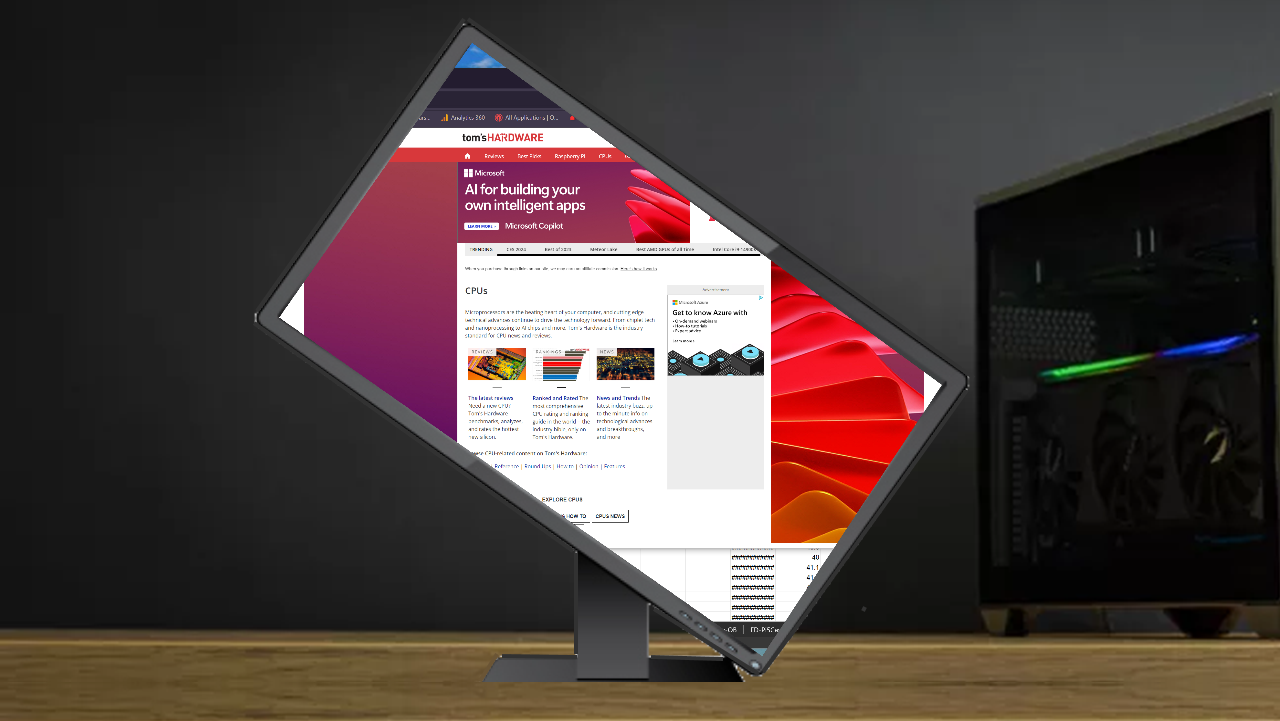Linux is the only OS to support diagonal PC monitor mode — dev champions the case for 22-degree-rotation computing
2024 could be the year of the Linux diagonal desktop.

Here's a fun tidbit — Linux is the only OS to support a diagonal monitor mode, which you can customize to any tilt of your liking. Latching onto this possibility, a Linux developer who grew dissatisfied with the extreme choices offered by the cultural norms of landscape or portrait monitor usage is championing diagonal mode computing. Melbourne-based xssfox asserts that the “perfect rotation” for software development is 22° (h/t Daniel Feldman).
Many PC enthusiasts have strong preferences for monitor setups. Some prefer ultrawides and curved screens, and others seek out squarer aspect ratios with flat screens. Multiple monitors are popular among power users, too. But what if you have an ultrawide and find the landscape or portrait choices too extreme? Xssfox was in this very situation and decided to use her nicely adjustable stand and the Linux xrandr (x resize and rotate) tool to try and find the ultimate screen rotation angle for software development purposes, which you can see if you expand the below tweet.
Linux is the only major operating system to support diagonal mode(credit @xssfox) https://t.co/OIFA1LWAlq pic.twitter.com/3oTxat4ciIDecember 27, 2023
Xssfox devised a consistent method to appraise various screen rotations, working through the staid old landscape and portrait modes, before deploying xrandr to test rotations like the slightly skewed 1° and an indecisive 45°. These produced mixed results of questionable benefits, so the search for the Goldilocks solution continued.
It turns out that a 22° tilt to the left (expand tweet above to see) was the sweet spot for xssfox. This rotation delivered the best working screen space on what looks like a 32:9 aspect ratio monitor from Dell. “So this here, I think, is the best monitor orientation for software development,” the developer commented. “It provides the longest line lengths and no longer need to worry about that pesky 80-column limit.”
If you have a monitor with the same aspect ratio, the 22° angle might work well for you, too. However, people with other non-conventional monitor rotation needs can use xssfox’s javascript calculator to generate the xrandr command for given inputs. People who own the almost perfectly square LG DualUp 28MQ780 might be tempted to try ‘diamond mode,’ for example.
We note that Windows users with AMD and Nvidia drivers are currently shackled to applying screen rotations using 90° steps. MacOS users apparently face the same restrictions.
Get Tom's Hardware's best news and in-depth reviews, straight to your inbox.

Mark Tyson is a news editor at Tom's Hardware. He enjoys covering the full breadth of PC tech; from business and semiconductor design to products approaching the edge of reason.
-
bit_user Reply
My thoughts, exactly.peachpuff said:Is it April 1st already?
For things like flight sims, I can see how you might want some monitors to be off-angle, but the suggestion that it's remotely suitable for development is just someone having a laugh. -
pixelpusher220 Reply
One thing I would like (and maybe it exists?) is the ability of a monitor to sense it's orientation and switch between portrait and landscapebit_user said:My thoughts, exactly.
For things like flight sims, I can see how you might want some monitors to be off-angle, but the suggestion that it's remotely suitable for development is just someone having a laugh. -
TerryLaze The way it is shown in the pic it makes some mild sense, if you only have one monitor and want to have your ide open and still see what and how your code is changing things, this gives you the most screen real estate possible.Reply
But then again 1080p monitors are so cheap that it still doesn't make sense.
Maybe for the three people that have space issues... -
USAFRet " “So this here, I think, is the best monitor orientation for software development,” the developer commented."Reply
You are high. -
bit_user Reply
My guess is that the window manager simply implemented multiple-orientation support as a generic 2D or 3D transform. Someone noticed that and decided to have a bit of fun.toffty said:Is this a sign of bloatware coming to Linux?
An advantage of using such a generic approach is that it's trivial to make the monitor mirror-backwards, which could actually have some practical applications. -
cryoburner Reply
Yeah, I kind of think this may have been intended as a joke about a mostly-useless feature. Having big diagonal sections of your application windows lopped off while there's simultaneously lots of unusable wasted space showing the desktop background is not likely going to be particularly good for productivity. Sure, you might be able to slightly increase the maximum line length visible on a single screen at once, but only for a few lines, with the rest being considerably shorter. Measuring the main application window in that photo, it's only a little over 2% wider than what could have fit in the standard orientation. And if they were really concerned about making space for things like a browser window, they could have just set it to be always-on-top over the bottom right corner of the application that's been cut off here. Or add a second smaller monitor for that purpose. Also, this appears to be a curved monitor, with the curve of the screen now running along a diagonal line. >_>bit_user said:My thoughts, exactly.
For things like flight sims, I can see how you might want some monitors to be off-angle, but the suggestion that it's remotely suitable for development is just someone having a laugh.